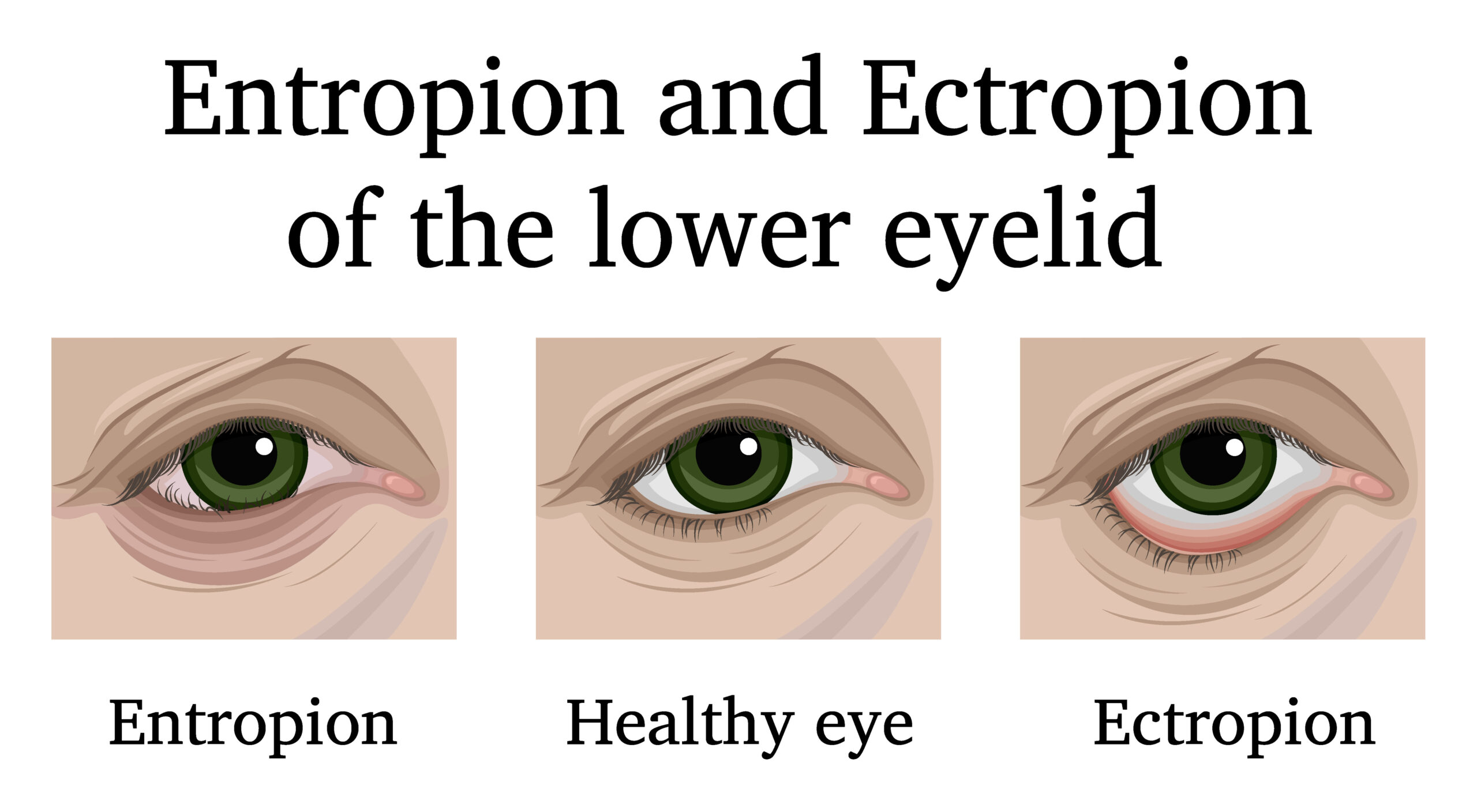What causes eyelid entropion ?
ENTROPION :
The eyelid may turn inward permanently, or it may only happen when the person shuts their eyes tightly or blinks hard. Entropion typically has a genetic cause. In some, rare cases, the lower eyelid has an extra fold of skin. If the condition affects both eyes, this is called bilateral entropion.
Entropion is very rare in children and young adults, but it may affect up to 2.1 percent of people over the age of 60 years, according to the American Academy of Ophthalmology. Entropion is a medical condition in which the eyelid folds inward. It usually occurs in the lower eyelid, but it can affect either. The reverse is a condition called ectropion, in which the eyelid turns outward.
A person with entropion will notice that their eyelashes and skin are rubbing against the cornea of the eye. This causes the eye to water, as well as inflammation, discomfort, irritation, or pain.
WHAT ARE THE SIGNS AND SYMPTOMS OF ENTROPION ?
Entropion causes many uncomfortable symptoms in your eye. When the condition first develops, symptoms may only occur occasionally. After time, however, the symptoms usually become constant. Signs of entropion include:
- irritation and a feeling that something is stuck in the eye
- excessive watering of the eyes, which is called epiphora
- crusting, or mucous discharge, on the eyelid
- pain in the eye
- sensitivity to light, which is called photophobia
- sensitivity of the eye to wind
- sagging skin around the eye
- redness in the whites of the eyes
Vision problems can also occur, especially if there is damage to the cornea.
WHAT ARE THE CAUSES OF ENTROPION ?
Aging can lead to entropion. As a person gets older, there is more loose skin around the eyelids, the muscles under the eyes weaken, and the tendons and ligaments in the area relax.
Scarring of the skin can be a contributing factor. Scarring may result from trauma, surgery, radiation to the face, or chemical burns. It can alter the natural curvature of the eyelid.
Also, a bacterial infection, such as trachoma, can cause the inner surface of the eyelids to become rough and scarred. The infection is uncommon in developed nations, but it affects tens of millions of people globally.
In addition, eye surgery can lead to eyelid spasms, which can cause the eyelid to fold inward.
Congenital issues can, rarely, cause entropion that is present from birth.
Lower eyelid looseness (laxity) usually causes entropion. Scarring can also cause your lid to turn inward (cicatricle entropion). Entropion is common in adults over the age of 60 because their eyelid supports weaken with age, allowing their eyelid muscles to turn their eyelids in. Other causes of an in-turned eyelid include an eye injury, infection or previous eye surgery.
HOW TO TREAT ENTROPION ?
Severe entropion can cause pain and loss of vision. Significant irritation can cause a corneal ulcer to develop, and this can become infected.
If the health of the eye is at risk, the doctor may recommend surgery.
After treatment for an infection or inflammation, the eyelid usually returns to its regular position. If this does not happen, and the eyelid still causes problems, a doctor may recommend surgery.
If surgery is not possible at that time, or if the person decides against it, some temporary treatments can help.
Transparent skin tape
Sticking transparent skin tape to the eyelid can stop it from folding inward.
The doctor will teach the person to place one end of the tape near the lower eyelashes and the other end on the upper cheek.
Botox
Injecting botox into the lower eyelid can relax the lid muscles and prevent them from contracting inward.
This is especially effective when entropion results from spasms.
However, the effects are temporary, lasting from 8–26 weeks, so some people require a series of injections. People with temporary entropion may prefer this treatment method.
Surgery
Several types of surgery can treat entropion. Factors influencing the choice will include:
- the underlying cause
- the state of the surrounding tissue
- the person’s age and overall health
Stitches
Usually, the stitches are absorbable and will dissolve or fall off in a few weeks. After the procedure, the eyelid tends to stay in position for several months.
A person can have the stitches at a doctor’s office, with local anesthesia, but this is a temporary solution.
The procedure also increases the risk of bruising, granuloma, and trichiasis, and it may not be effective in some people.
Other surgical options
If entropion results from aging and the relaxation of muscles, ligaments, or tendons, a surgeon can remove a small part of the lower eyelid. This will tighten the tendons and muscles.
After the procedure, the person will have some stitches on the outside corner of the eye or just under the lower eyelid.
If entropion develops because of scar tissue or a previous surgical procedure, the surgeon may take some skin from behind the ear or the upper eyelid and graft it onto the lower eyelid.
After surgery
After surgery, the person will have to wear an eye patch for approximately 24 hours.
The physician will prescribe:
- antibiotics to protect against postsurgical infection
- steroids to prevent inflammation
Acetaminophen (Tylenol) can often alleviate discomfort and swelling. Gently applying a cold compress to the area may also help.
Within around 7 days, the doctor will remove the stitches.



Comments
Post a Comment